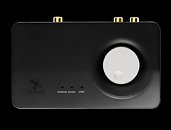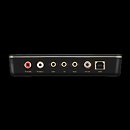Wednesday, December 14th 2016

ASUS Also Announces the Xonar U7 MkII External Sound Card
ASUS today announced Xonar U7 MKII, a high-quality USB sound card and headphone amplifier. The compact Xonar U7 MKII is an upgraded version of the acclaimed Xonar U7 and features true 7.1-channel,192kHz/24-bit high-definition (HD) surround-sound output for incredible audio performance. Xonar U7 MKII comes with ASUS Sonic Studio, a software utility with an intuitive single-screen interface that provides complete control over a wide range of audio features, and Sonic Radar Pro, a feature for gamers that visually maps in-game sounds in first-person shooter (FPS) games to provide a competitive advantage.
ASUS Xonar U7 MKII retains the compact USB-powered design that was a highlight of the original Xonar U7 and delivers true 7.1-channel, 192kHz/24-bit HD audio, outperforming most available USB-powered audio devices. With a high-quality Cirrus Logic CS4398 digital-to-analog converter (DAC) and exclusive ASUS Hyper Grounding technology, Xonar U7 MKII has a 114dB signal-to-noise ratio (SNR), ensuring ultra-pure sound for the best listening experiences. The small size of Xonar U7 MKII takes up minimal room on a desk, and makes it easily portable, so laptop users can enjoy great-sounding audio anywhere.Enhanced gaming and media streaming
ASUS Xonar U7 MKII is great for gaming and media streaming with dedicated headphone and microphone controls that let users make instant audio adjustments without interrupting their game or entertainment. The master volume control knob doubles as an output selector, so users can keep their speakers and headphones connected and conveniently switch between them with a simple click of a button. Additionally, USB connectivity enables both laptop and desktop users to easily upgrade their system's audio performance and enjoy incredible gaming and media streaming experiences.
Complete and intuitive audio control
ASUS Xonar U7 MKII comes with Sonic Studio, a full-featured and easy-to-use sound utility that gives users complete control over a wide range of audio features, such as equalization (EQ) and 7.1 surround speaker level-balancing. Unlike typical audio utilities with multi-screen interfaces that make configuration complicated and time-consuming, Sonic Studio has an intuitive all-in-one view that puts all the necessary audio controls on a single screen to make adjustments fast and easy.
Sonic Studio also includes controls for Sonic Radar Pro, a unique feature that precisely maps in-game sounds - such as footsteps and gunshots - and displays them on an on-screen overlay, so gamers can pinpoint their enemies for a competitive advantage in FPS games. Sonic Studio is fully compatible with Windows 10.
Specifications:
ASUS Xonar U7 MKII retains the compact USB-powered design that was a highlight of the original Xonar U7 and delivers true 7.1-channel, 192kHz/24-bit HD audio, outperforming most available USB-powered audio devices. With a high-quality Cirrus Logic CS4398 digital-to-analog converter (DAC) and exclusive ASUS Hyper Grounding technology, Xonar U7 MKII has a 114dB signal-to-noise ratio (SNR), ensuring ultra-pure sound for the best listening experiences. The small size of Xonar U7 MKII takes up minimal room on a desk, and makes it easily portable, so laptop users can enjoy great-sounding audio anywhere.Enhanced gaming and media streaming
ASUS Xonar U7 MKII is great for gaming and media streaming with dedicated headphone and microphone controls that let users make instant audio adjustments without interrupting their game or entertainment. The master volume control knob doubles as an output selector, so users can keep their speakers and headphones connected and conveniently switch between them with a simple click of a button. Additionally, USB connectivity enables both laptop and desktop users to easily upgrade their system's audio performance and enjoy incredible gaming and media streaming experiences.
Complete and intuitive audio control
ASUS Xonar U7 MKII comes with Sonic Studio, a full-featured and easy-to-use sound utility that gives users complete control over a wide range of audio features, such as equalization (EQ) and 7.1 surround speaker level-balancing. Unlike typical audio utilities with multi-screen interfaces that make configuration complicated and time-consuming, Sonic Studio has an intuitive all-in-one view that puts all the necessary audio controls on a single screen to make adjustments fast and easy.
Sonic Studio also includes controls for Sonic Radar Pro, a unique feature that precisely maps in-game sounds - such as footsteps and gunshots - and displays them on an on-screen overlay, so gamers can pinpoint their enemies for a competitive advantage in FPS games. Sonic Studio is fully compatible with Windows 10.
Specifications:
- Output signal-to-noise ratio (A-weighted): Up to 114dB
- Input signal-to-noise ratio (A-weighted): 110dB
- Output total harmonic distortion + noise at 1khz (A-weighted): Up to 0.0006% (104dB)
- Input total harmonic distortion + noise at 1kHz (A-weighted): Up to 0.001% (-100dB)
- Frequency response (-3dB, 24-bit/96kHz input ): <10Hz to 46kHz
- Output/input full-scale voltage:
- Rear output (Speaker) 1Vrms (2.828 Vp-p)
- Headphone 1.3Vrms (3.677 Vp-p)
- Line-in 1Vrms (3.677Vp-p)
- Bus Compatibility: USB audio class, USB audio class 2.0 for all functions, USB audio class 1.0 for playback
- Main Chipset (Audio processor): CMedia CMI6632AX High-performance sound processor (Max. 192KHz/24-bit)
- D-A converter (digital sources): 1 x Cirrus CS4398 (120dB SNR, Max. 192kHz/24-bit), 1 x Cirrus CS4362 (114dB SNR, Max. 192kHz/24-bit)
- A-D converter (analog input): 1x Cirrus CS5361 (114dB SNR, Max. 192kHz/24-bit)
- Analog playback sample rate and resolution: 44.1K/48K/88.2K/96K/172.4K/192KHz @ 16/24-bit
- Analog recording sample rate and resolution: 44.1K/48K/88.2K/96KHz/172.4K/192K @ 16/24-bit
- S/PDIF digital output: 44.1K/48K/88.2K/96K/172.4K/192KHz @ 16/24-bit
- ASIO 2.0 driver support: 44.1K/48K/88.2K/96K/172.4K/192KHz @ 16/24-bit
- Operating system support: Windows 10/8.1/7(32/64-bit)



14 Comments on ASUS Also Announces the Xonar U7 MkII External Sound Card
Is it a USB 2.0 Full or High Speed device? (Because of USB isolation devices).
Would like to see some photo of innards... anyone seen?
Also weirdly enough still having the same poor design with different analog outputs for front and surround channels, where you need to buy extra RCA to 3.5mm dongle from amazon or something to operate this in analog surround setting. ( www.amazon.com/dp/B0002GUBIS/?tag=tec06d-20 ). This dongle SHOULD HAVE BEEN INCLUDED this time around!
Also although it on picture seems to have S/PDIF out, no mention about DTS or DDL - was this overlooked? or missing entirely?
You can use any generic driver for it probably... CMI6632 like from Schiit for example. I use it for my Asus Thunderbolt hybrid card that surprisingly decent audio part. With same part combo. Had to use Schiit drivers as ASUS usually... doesn't give sound drivers :D.
CM6632 is supported by XP. You will have to poke around to get it working, but not completely hopeless. Linux should work out of the box.
And... yes... in the whole world RCA connectors are one of the THE WORST things made by man... who was in his LSD trip getting a positive signal terminal before the ground terminal... yes there are some advanced neutrik connectors that mend it... but it's a workaround... still one of most stupid things used in consumer electronics.
@Ferrum Master: Put a nice set of those Neutriks on my Dual 505-3 when I rewired it, excellent connectors :D
These guys have been great to me over the years, from building power cords to rewiring a tonearm :toast:
Bummed they don't carry 4s11any longer as I need to make a couple more sets of speaker cables...
1/4 TRS? Mostly 'pro' stuff you're using then?
I use a properly modded X-FI HD USB mostly for measuring other devices... it is cheap and thus not afraid to burn it out, decent ADC. I have killed many devices while working - that's layf... Easy to debug most problems without using more serious and expensive spectrum analyzers for fighting noise anomalies etc things.
Also... USB is a really shitty[read noisy] thing for audio actually... especially if the device is powered from the same port. Any USB radio containing device needs a USB isolator... or use it from batteries... if you plug it to the mains(like charging or using a PC) then the fun starts and you cannot measure two devices, there are many kind of distortion ringing in the rails. There are cheap ADuM4160 based devices for hispeed, pop it a bluetooth dongle even in it and it will work much more better due to enormously lower noise floor. RTL-SDR any other devices use them as a must... Full Speed isolators are expensive thou.
Here a pic from some shitty USB dac... one with and one without isolation. You will get the idea how things work. It is not about the averaged percentage of noise(that actually looks still good in the table)... but about them harmonic spikes in the graphs... Most sound card reviewers should be put in line and shot :D They don't understand a thing and usually believe in imaginary friends(right/mellow/airy/transparent sound).
@AsRock Looks like the old one... Actually really wanted to tell like, find at least 3 differences.
There is no datasheet about this X. Some wild guess could be about processing some effects. And hardware bugfixes... hey... it is a cmedia device :D
I wonder if it has the USB 1.1 mode switch... that could be it actually!
Because I'm in love again with my Akai GX deck, I'd like to transfer my FLAC, APE, SHN and other 24bits/192kHz albums to tapes.
I'm interested only for stereo output so please let me know if the 2 RCA stereo outputs delivery same quality signals like the original digital material.
In other words, it worth to buy it for this purpose.
Thanks !
And please excuse my broken english.